2019 VOLKSWAGEN E-GOLF fuse
[x] Cancel search: fusePage 256 of 394
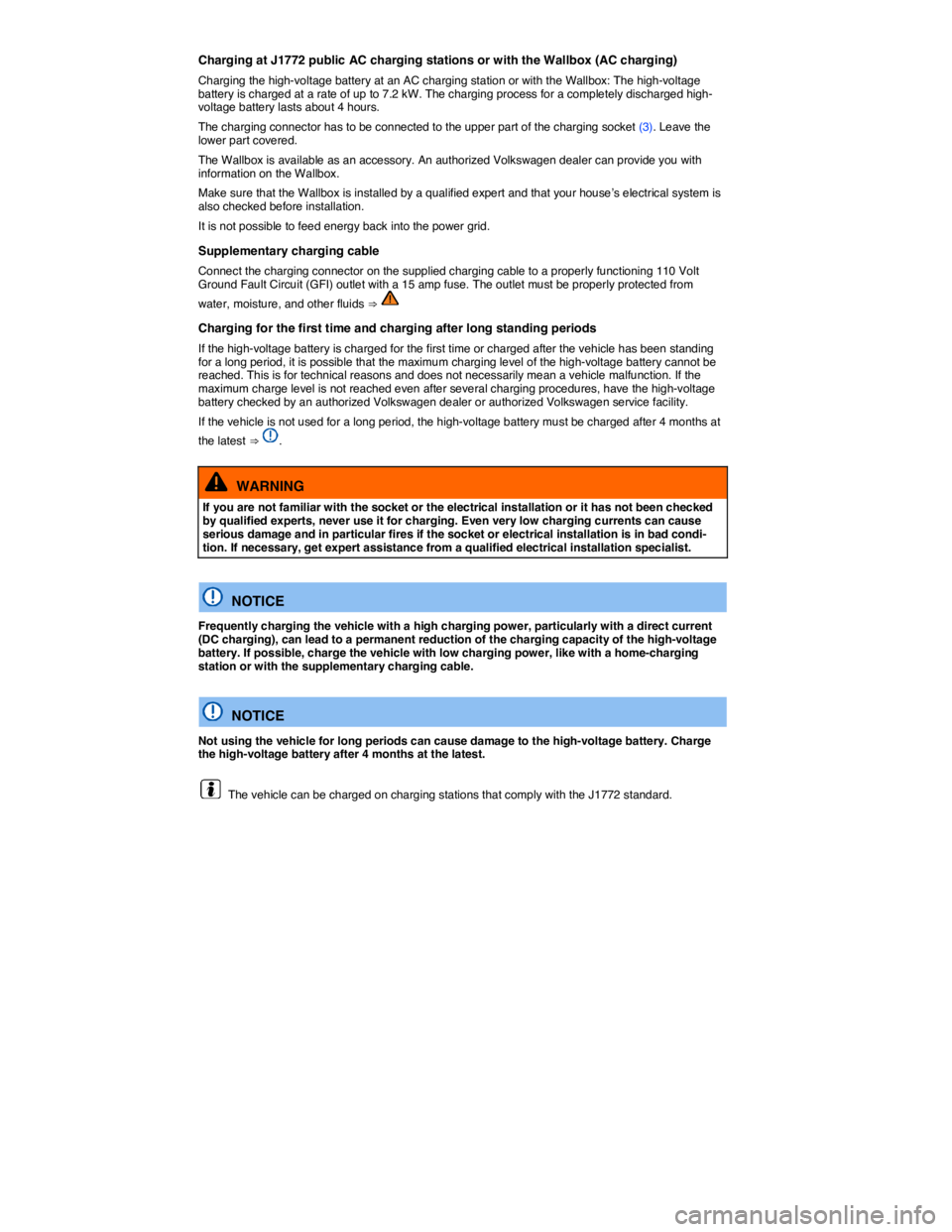
Charging at J1772 public AC charging stations or with the Wallbox (AC charging)
Charging the high-voltage battery at an AC charging station or with the Wallbox: The high-voltage battery is charged at a rate of up to 7.2 kW. The charging process for a completely discharged high-voltage battery lasts about 4 hours.
The charging connector has to be connected to the upper part of the charging socket (3). Leave the lower part covered.
The Wallbox is available as an accessory. An authorized Volkswagen dealer can provide you with information on the Wallbox.
Make sure that the Wallbox is installed by a qualified expert and that your house’s electrical system is also checked before installation.
It is not possible to feed energy back into the power grid.
Supplementary charging cable
Connect the charging connector on the supplied charging cable to a properly functioning 110 Volt Ground Fault Circuit (GFI) outlet with a 15 amp fuse. The outlet must be properly protected from
water, moisture, and other fluids ⇒
Charging for the first time and charging after long standing periods
If the high-voltage battery is charged for the first time or charged after the vehicle has been standing for a long period, it is possible that the maximum charging level of the high-voltage battery cannot be reached. This is for technical reasons and does not necessarily mean a vehicle malfunction. If the maximum charge level is not reached even after several charging procedures, have the high-voltage battery checked by an authorized Volkswagen dealer or authorized Volkswagen service facility.
If the vehicle is not used for a long period, the high-voltage battery must be charged after 4 months at
the latest ⇒ .
WARNING
If you are not familiar with the socket or the electrical installation or it has not been checked by qualified experts, never use it for charging. Even very low charging currents can cause serious damage and in particular fires if the socket or electrical installation is in bad condi-tion. If necessary, get expert assistance from a qualified electrical installation specialist.
NOTICE
Frequently charging the vehicle with a high charging power, particularly with a direct current (DC charging), can lead to a permanent reduction of the charging capacity of the high-voltage battery. If possible, charge the vehicle with low charging power, like with a home-charging station or with the supplementary charging cable.
NOTICE
Not using the vehicle for long periods can cause damage to the high-voltage battery. Charge the high-voltage battery after 4 months at the latest.
The vehicle can be charged on charging stations that comply with the J1772 standard.
Page 264 of 394

Temperature monitoring
During the charging process the charging cable can become slightly warmer. This is normal and no cause for concern
If the control unit or the charging cable becomes too hot, the charging current will automatically be reduced If the control unit or the charging cable continues to get hot even at the lowest charging current, the protection unit will be switched off, and will remain switched off until it has cooled down sufficiently.
If no other sources of heat, such as direct sunlight, can be identified as relevant, have the outlet checked by properly qualified and trained experts.
Charging cable for charging at charging stations (if equipped)
Keep the charging cable for charging at a charging station safely in its bag in the luggage compart-ment. Follow the operating manual for the charging station. Before using the charging cable, read the procedure for charging with alternating current
WARNING
Charging the high-voltage battery improperly, using improper or damaged outlets and charg-ing cables, improper handling of the high-voltage battery or failure to follow safe charging procedures can cause short circuits, electric shock, explosions, fire, burns, injuries and death.
�x Always connect the charging cable to a properly functioning 110 Volt Ground Fault Circuit (GFI) wall outlet. The outlet must be properly protected from water, moisture and other fluids.
�x Always check the fuse protection of the GFI outlet before connecting the charging cable.
�x Never connect the charging cable to a conventional power outlet, regardless of whether the outlet is protected or not.
�x Never use the charging cable with an extension cord of any kind.
�x Never let plugs or connectors come into contact with water, moisture, or any other fluids.
�x Never use any charging cable if it is damaged and never use the charging cable with a damaged GFI outlet.
�x Never attempt to alter or repair cables or other electrical components.
�x Never let anybody stay in the vehicle while the high-voltage battery is charging.
�x Never do any kind of work on the outside or inside of the vehicle while the high-voltage battery is charging.
�x Always disconnect the charging cable completely from the vehicle before starting the motor.
WARNING
If you are not familiar with the outlet or the electrical installation or it has not been checked by qualified experts, never use it for charging. Even very low charging currents can cause serious damage and in particular fires if the socket or electrical installation is in bad condi-tion. If necessary, get expert assistance from a qualified electrical installation specialist.
WARNING
If a 110 Volt outlet is being used for charging, never charge 2 or more vehicles on outlets of the same fuse at the same time. Use a different fuse circuit for charging another vehicle. Al-ways comply with the maximum load for the fuse circuit used. If necessary, get expert assis-tance.
Page 265 of 394
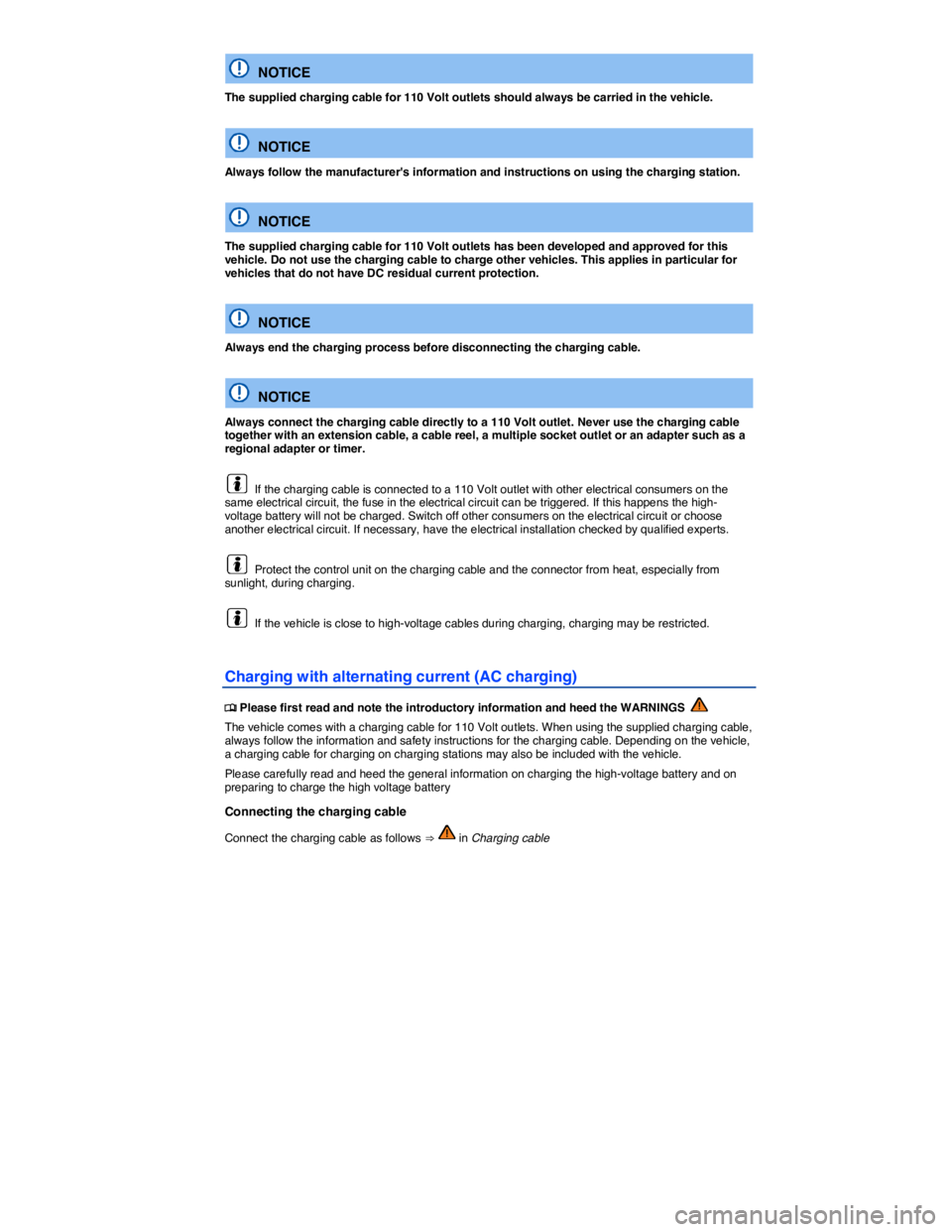
NOTICE
The supplied charging cable for 110 Volt outlets should always be carried in the vehicle.
NOTICE
Always follow the manufacturer's information and instructions on using the charging station.
NOTICE
The supplied charging cable for 110 Volt outlets has been developed and approved for this vehicle. Do not use the charging cable to charge other vehicles. This applies in particular for vehicles that do not have DC residual current protection.
NOTICE
Always end the charging process before disconnecting the charging cable.
NOTICE
Always connect the charging cable directly to a 110 Volt outlet. Never use the charging cable together with an extension cable, a cable reel, a multiple socket outlet or an adapter such as a regional adapter or timer.
If the charging cable is connected to a 110 Volt outlet with other electrical consumers on the same electrical circuit, the fuse in the electrical circuit can be triggered. If this happens the high-voltage battery will not be charged. Switch off other consumers on the electrical circuit or choose another electrical circuit. If necessary, have the electrical installation checked by qualified experts.
Protect the control unit on the charging cable and the connector from heat, especially from sunlight, during charging.
If the vehicle is close to high-voltage cables during charging, charging may be restricted.
Charging with alternating current (AC charging)
�
Page 377 of 394
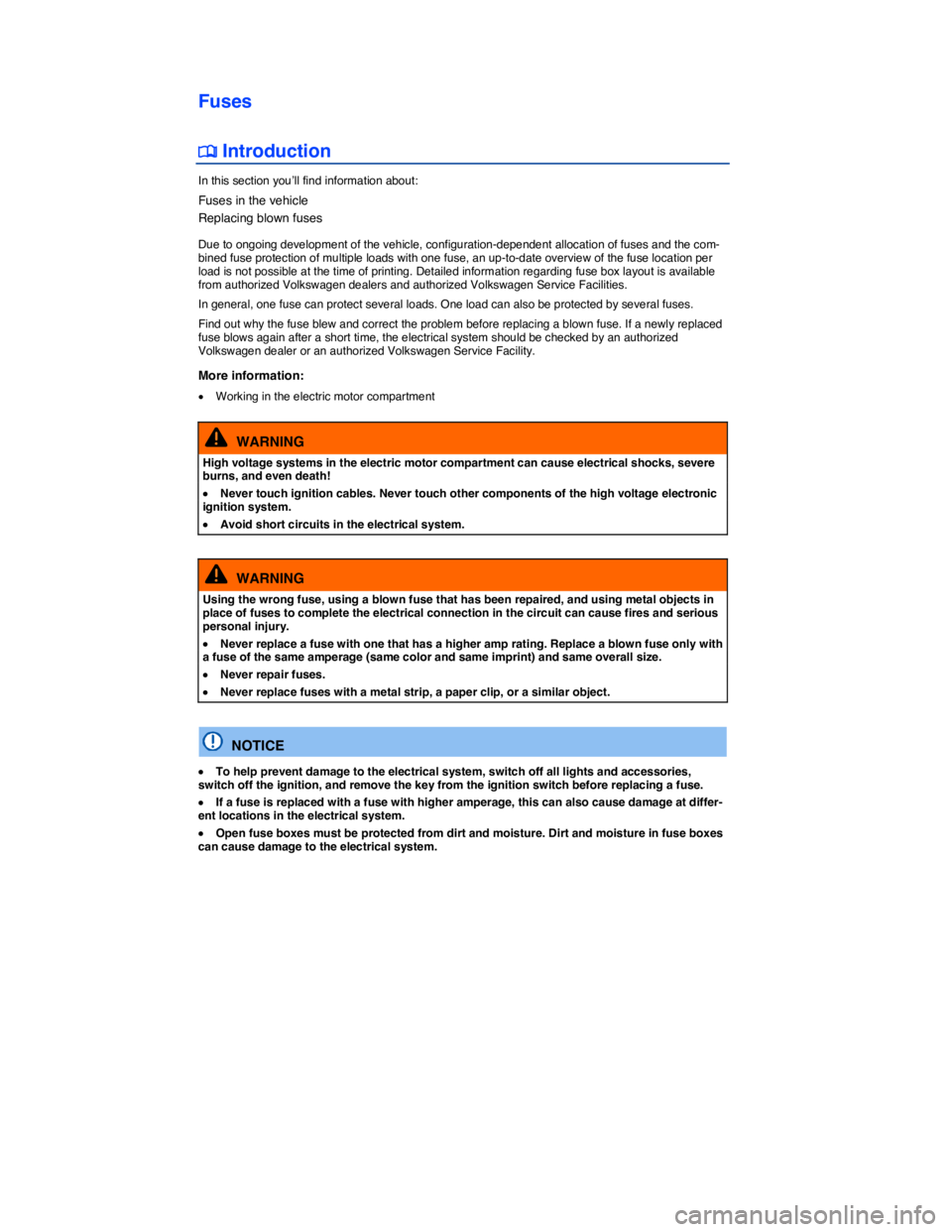
Fuses
�
Page 378 of 394
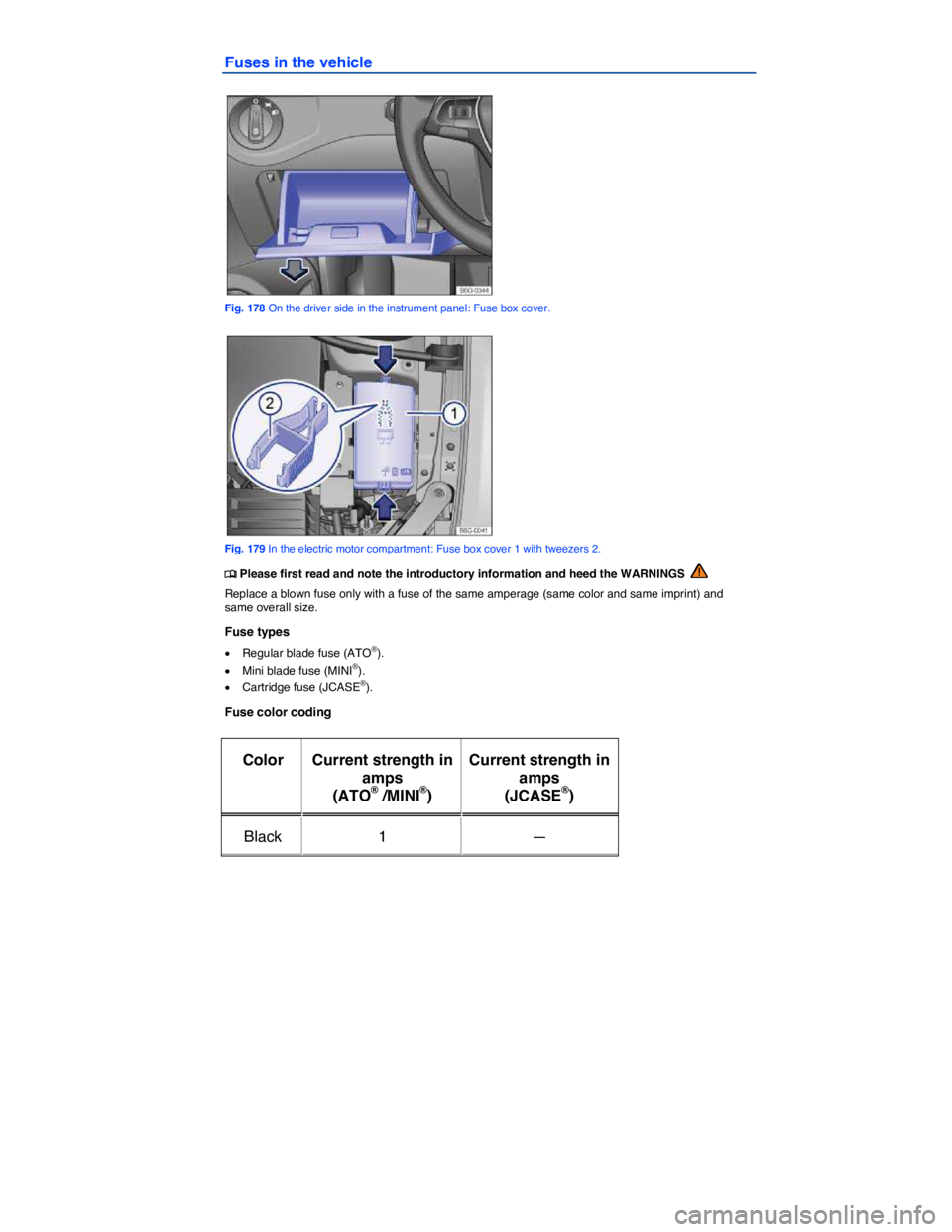
Fuses in the vehicle
Fig. 178 On the driver side in the instrument panel: Fuse box cover.
Fig. 179 In the electric motor compartment: Fuse box cover 1 with tweezers 2.
�
Page 379 of 394
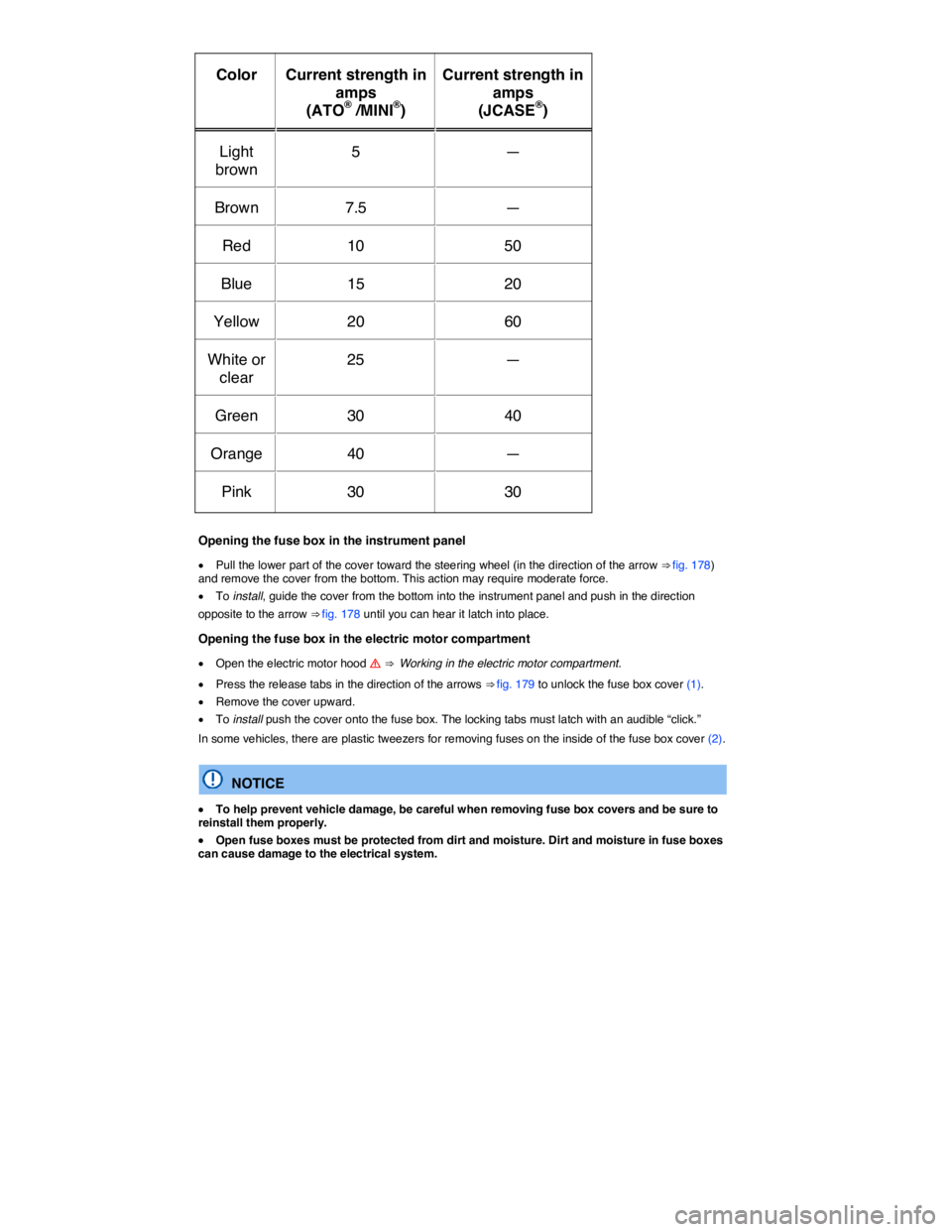
Color Current strength in
amps
(ATO® /MINI®)
Current strength in
amps
(JCASE®)
Light
brown
5 —
Brown 7.5 —
Red 10 50
Blue 15 20
Yellow 20 60
White or
clear
25 —
Green 30 40
Orange 40 —
Pink 30 30
Opening the fuse box in the instrument panel
�x Pull the lower part of the cover toward the steering wheel (in the direction of the arrow ⇒ fig. 178) and remove the cover from the bottom. This action may require moderate force.
�x To install, guide the cover from the bottom into the instrument panel and push in the direction
opposite to the arrow ⇒ fig. 178 until you can hear it latch into place.
Opening the fuse box in the electric motor compartment
�x Open the electric motor hood �
Page 380 of 394
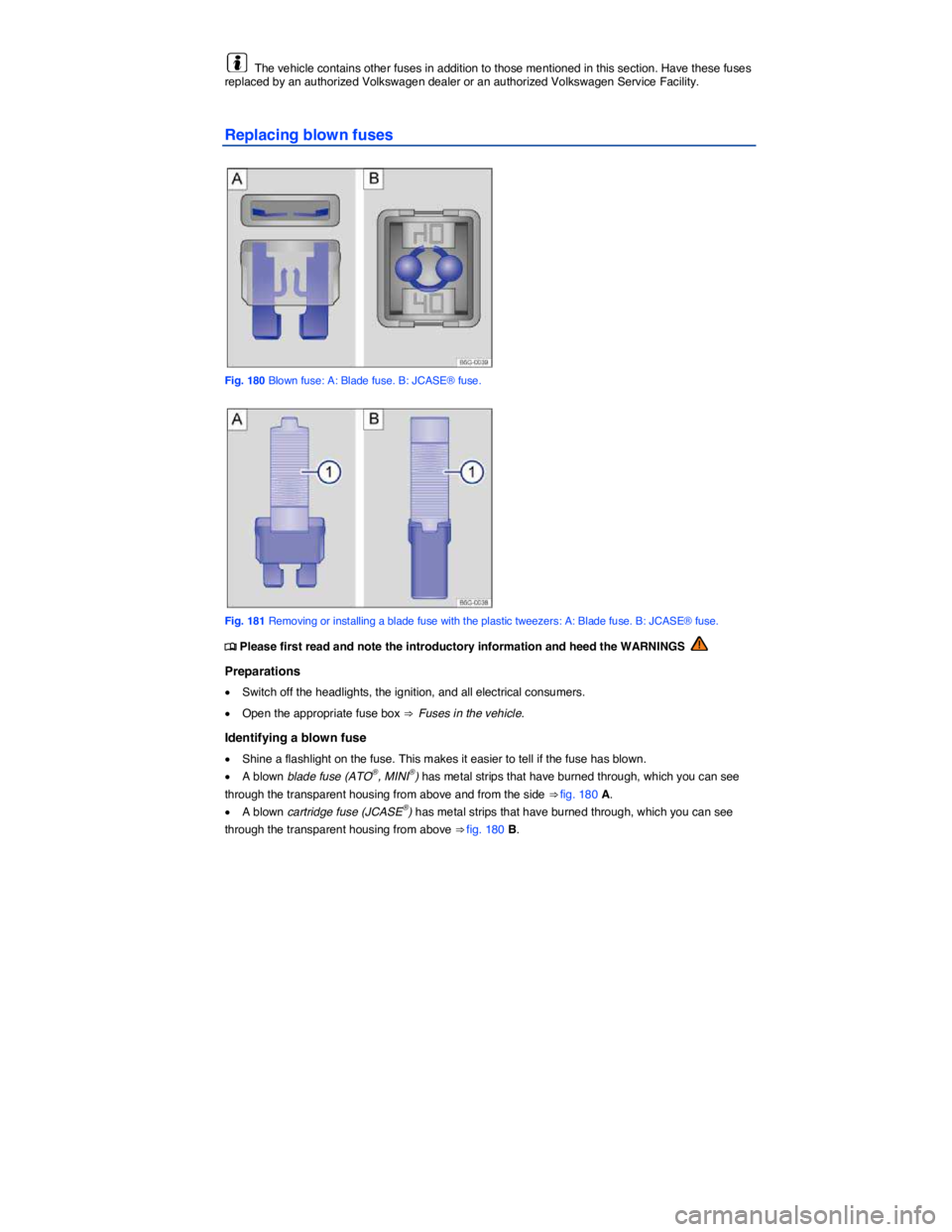
The vehicle contains other fuses in addition to those mentioned in this section. Have these fuses replaced by an authorized Volkswagen dealer or an authorized Volkswagen Service Facility.
Replacing blown fuses
Fig. 180 Blown fuse: A: Blade fuse. B: JCASE® fuse.
Fig. 181 Removing or installing a blade fuse with the plastic tweezers: A: Blade fuse. B: JCASE® fuse.
�
Page 381 of 394

Replacing a fuse
In some vehicles, there are plastic tweezers for removing blade fuses on the inside of the fuse box cover in the electric motor compartment.
�x Open the fuse box cover in the electric motor compartment ⇒ Fuses in the vehicle and remove the plastic tweezers.
�x Depending on the type of fuse, slide the tweezers ⇒ fig. 181 A (1) or ⇒ fig. 181 B (1) onto the fuse from the side.
�x Pull out the fuse.
�x If the fuse is blown, replace the fuse with a new fuse of the same amperage (same color and same
imprint) and same size ⇒ .
�x Clip the plastic tweezers back into the holder inside the fuse box cover.
�x Replace the fuse box cover.
NOTICE
If a fuse is replaced with a fuse with higher amperage, then damage can occur at various plac-es in the electrical system.